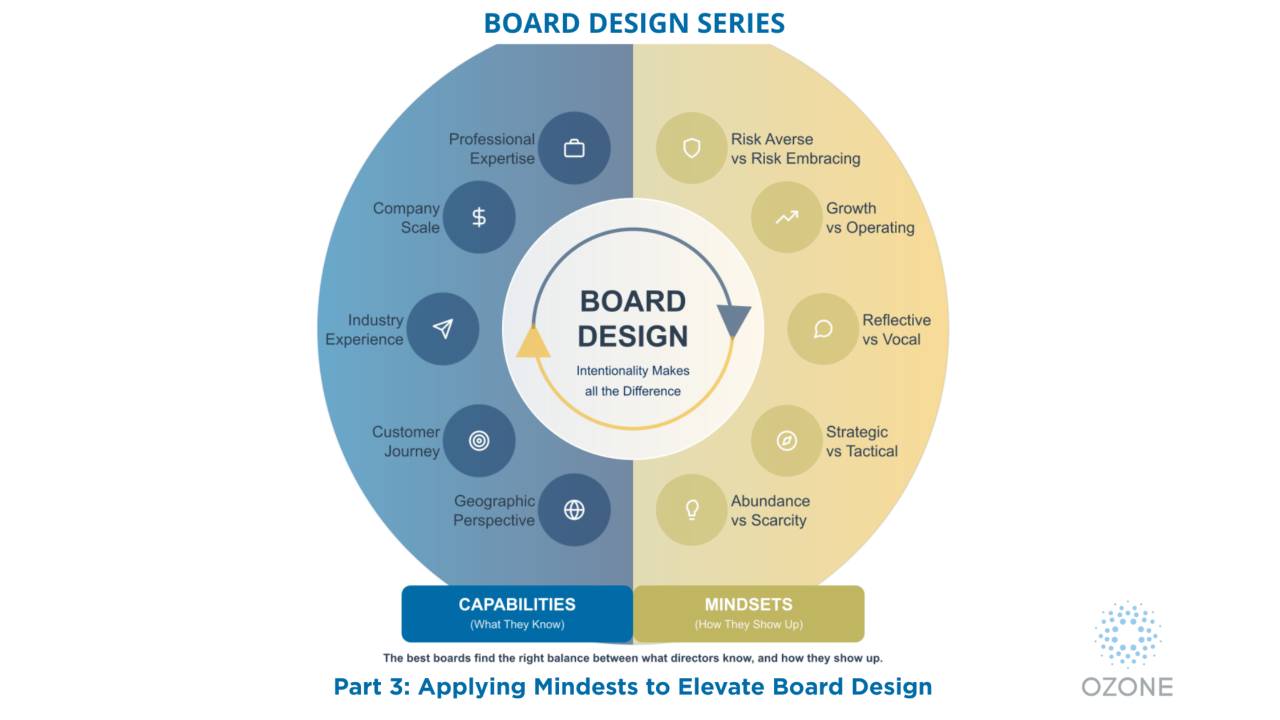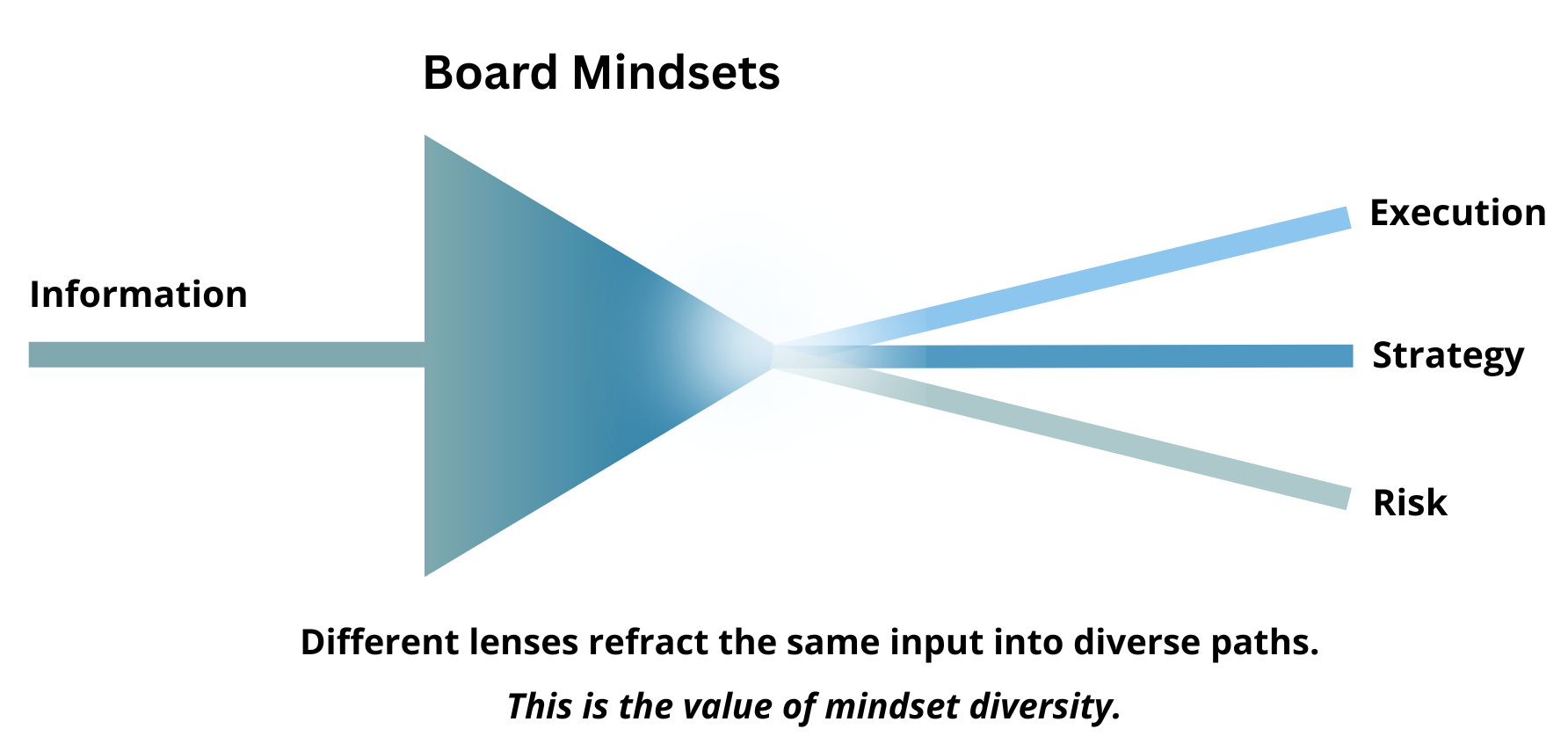Applying Mindsets to Elevate Board Design

By Darren Rawson
Darren Rawson is the chair of five private companies including AltaML and Chandos Construction. He’s a former CEO of three different private companies and has done business internationally for over 25 years in numerous industry sectors.
This is the third and final article of our series on Board Design, bringing together the elements that make an exceptional board.
Recap of Parts 1 and 2:
- Principles of designing your board: exploring why mindsets and capabilities are a key enhancement to the classic skills matrix.
- Capabilities in focus: a deep dive into capabilities versus skills and the value of using more explicit criteria to get towards ideal board composition.
This final article brings those foundations together to introduce the last element in Ozone’s approach to board design: the mindsets that help create an exceptional board.
Why Do Mindsets Matter?
Beliefs shape how people notice, decide, and act.
- Skills describe what a director knows.
- Capabilities describe what a director can do.
- Mindsets describe how a director analyzes and decides.
Together, they drive decisions, outcomes, and results.
Mahatma Gandhi had a famous quote:
“Your beliefs become your thoughts,
your thoughts become your words,
your words become your actions,
your actions become your habits,
your habits become your values,
your values become your destiny.”
Gandhi highlights how beliefs, not skills or experiences, shape actions, habits, and ultimately destiny.
Most boards optimize for skills. Advanced boards optimize for skills and experiences (or in other words for capabilities). High-performing boards understand the value of diversity of thought and optimize for all three: skills, experiences and mindsets amongst directors.
One of the biggest risks for boards is groupthink. Building mindset diversity is one of the most powerful ways to reduce that risk, leading to richer debates and better decisions.

Understanding Mindsets
In simple terms, a mindset is a set of attitudes that shape how a person (or group) views culture, values, philosophy, frame of reference, outlook and/or disposition. (Oxford University Press, 2022)
There is no single right or wrong way to think about mindsets on a board. The key is to seek diversity of thinking styles without labeling directors.
A well known framework comes from Carol Dweck’s research: This example shows that having both thinking styles on a board could be invaluable in strategic conversations and contemplating risks.
This example shows that having both thinking styles on a board could be invaluable in strategic conversations and contemplating risks.
Applying Mindsets in Board Design
Applying mindsets to board design is important, but it can be challenging. The good news is that it does not have to be perfect. The goal is to bring different ways of thinking to the table.
A practical way to approach this is by exploring mindset pairs, two equally valuable opposite thinking styles that can balance and strengthen the board.
In this method treat both sides as strengths. Aim for a mix that fits strategy and risk appetite.

Tips to Apply Mindsets
- Start with Intent
Anchor desired mindsets in shareholder aspirations, enterprise strategy, and risk appetite. Document why each mindset matters so selection and debate stay objective. - Diagnose the Current Board
Use interviews, observation, and self-reflection tools to understand how each director naturally approaches risk, growth, and decision-making. Present all mindset pairs as equally valuable to promote openness and avoid defensiveness. - Identify Imbalances and Opportunities
Compare current thinking styles against the board’s strategic needs. For example, you might find a strong concentration of Operating and Scarcity mindsets but fewer Risk Embracing or Growth-oriented perspectives. Highlight where diversity of thought could strengthen discussion and resilience. - Apply and Reinforce Mindsets
Use mindset awareness when planning succession, committee composition, and board development. In meetings, balance airtime by inviting Reflective voices, moderating Vocal ones, and rotating who frames key discussions. Reinforce awareness of thinking styles through chair facilitation and regular board reviews.
Finding the Right Balance
There are no right or wrong mindset combinations. Each board will need a mix that fits its strategy, aspirations, and risk appetite.
Some boards benefit from a balance across mindsets, while others may lean toward one side. For example, a high-growth organization with bold ambitions might lean toward Risk Embracing directors, balanced by a few Risk Averse voices as counterweights.
Mindset diversity can also reflect shared experiences rather than thinking styles. A board serving a specific community or population segment, such as a rural population, may seek directors who relate to that segment through their lifestyle or experiences.
Perfection is not required. Mindsets can be explored through interviews, observation, or self-assessment. The goal is progress toward greater diversity of thought, not precision.

Conclusion
Capabilities make a board effective. Mindsets make a board wise.
The right mix produces better debates, better tradeoffs, and better outcomes.
A board with diverse mindsets will likely have grittier, more challenging conversations, and that is a good thing. The discomfort that comes with difference is often the birthplace of better decisions.
As we close this Board Design Series, the message is simple: adding mindset diversity into your board design process is a critical addition to help get an ideal board. As we always say, if you are going to have an active board, have an amazing one!

